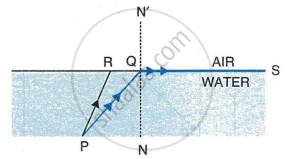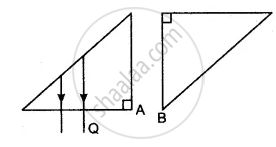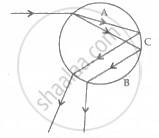Advertisements
Advertisements
प्रश्न
Answer the following question.
What are the advantages of optical fibre communication over electronic communication?
उत्तर
Advantages:
- Broad bandwidth (frequency range): For TV signals, a single optical fibre can carry over 90000 independent signals (channels).
- Immune to EM interference: Optical fibre being electrically non-conductive, does not pick up nearby EM signals.
- Low attenuation loss: loss being lower than 0.2 dB/km, a single long cable can be used for several kilometres.
- Electrical insulator: Optical fibres being electrical insulators, ground loops of metal wires or lightning do not cause any harm.
- Theft prevention: Optical fibres do not use copper or other expensive material which are prone to be robbed.
- Security of information: Internal damage is most unlikely to occur, keeping the information secure.
APPEARS IN
संबंधित प्रश्न
The diagram below shows a point source P inside a water container. Four rays A, B, C, D starting from the source P are shown up to the water surface

1) Show in the diagram the path of these rays after striking the water surface.
The Critical Angle for the water-air surface is 48°.
2) Name the phenomenon which the rays B and D exhibit.
State the relation between the critical angle and the absolute refractive index of a medium.
In the given figure PQ and PR are the two light rays emerging from an object P. The ray PQ is refracted as QS.

- State the special name given to the angle of incidence ∠PQN of the ray PQ.
- What is the angle of refraction for the refracted ray QS?
- Name the phenomenon that occurs if the angle of incidence ∠PQN is increased.
- The ray PR suffers partial reflection and refraction on the water-air surface. Give reason.
- Draw in the diagram the refracted ray for the incident ray PR and hence show the position of image of the object P by the letter P’ when seen vertically from above.
Write the relation between the refractive index and critical angle for a given pair of optical media?
The observation made by Swarali while doing the experiment is given below. Based on these write answers to the questions:
Swarali found that the light ray travelling from the denser medium to rarer medium goes away from the normal. If the angle of incidence (i) is raised by Swarali, the angle of refraction (r) went on increasing. However, after certain value of the angle of incidence the light ray is seen to return back into the denser medium.
Questions:
- What is the specific value of∠i called?
- What is the process of reflection of incident rays into denser medium called?
- Draw the diagrams of three observations made by Swarali.
Plot a graph between
Sine of angle of incidence versus sine of angle of refraction,
How does a ray of light bend when it travels from rarer to denser medium
If a ray of light passes from medium I to medium II without any change of direction, what can be said about the refractive indices of these media (angle I is not 0)?
How are critical angles related to the refractive index of the medium?
A ray of light incident at an angle of incidence ‘i’ passes through an equilateral glass prism such that the refracted ray inside the prism is parallel to its base and emerges from the prism at an angle of emergence ‘e’.
What can you say about the value of the angle of deviation in such a situation?
Draw a diagram, properly labelled, to illustrate the use of a total reflecting prism (a right-angled isosceles prism) to turn a ray of light through 180°. Name an instrument in which this device is used.
The adjacent diagram shows two right-angled isosceles prisms A and B. Complete the diagram to show the path of rays P and Q emerging out of the prism B. What principles have you used to complete the diagram?

A ray of light is incident as a normal ray on the surface of separation of two different mediums. What is the value of the angle of incidence in this case?
Choose the correct option.
Angles of deviation for extreme colours are given for different prisms. Select the one having maximum dispersive power of its material.
Which of the following is not involved in formation of a rainbow?
Which one of the following is NOT the correct formula for refractive index of glass w.r.t. air (aμg) (i = angle of incidence, r = angle of refraction)
For total internal reflection to take place, the angle of inddence i and the refractive index µ of the medium must satisfy the inequality ____________.
The critical angle is defined as the angle of incidence at which the total internal reflection starts to occur.
Define the critical angle.
Write any two uses of total internal reflection.
The phenomena involved in the reflection of radiowaves by ionosphere is similar to ______.
Observe the given figure of the raindrop and answer the following questions:

- Label A and B of the given diagram. Why colour will deviate most.
- Name the phenomenon shown in label C.
A light is entering from one medium refractive index `("RI" =5/3)` to another medium at an angle 30°. The angle of refraction for other medium is sin-1 `(5/6)`. then the increase in angle of incidence is ______ such that the ray of light reflected back into the same medium.
